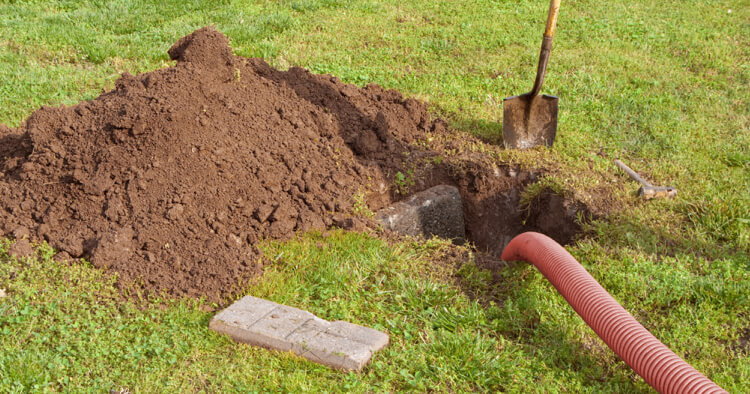How to keep Septic Tank pumping costs to a minimum

Nobody likes to deal with the awful smell of sewage in the house, not to mention dirty, stinky water in the front yard.
[1]:
[2]: /en-us/assets/images/blog/HomeServe-CTAsAvailablePlan.jpg
[3]: /en-us/assets/images/blog/HomeServe-CTAsViewPlan.jpg
If you’re experiencing these issues, it most likely means your septic tank is full, or damaged, or there’s a drain field issue. Odors and water pooling are common symptoms, but there are other symptoms that can include slow house drains, gurgling pipes and a very green patch of grass in the drain field area.
Why Septic Tank pumping?
Homeowners are responsible for maintaining their septic tanks and drain fields. So you may be wondering just how much does septic tank pumping cost?
The septic tank pumping cost is dependent on a number of factors. The Environmental Protection Agency (EPA) requires a septic tank to be pumped when the scum (top) layer reaches within 6 inches of the outlet pipe. Unfortunately, you may not discover your septic tank is full until there is a problem, like foul odors coming out of your drains, or even worse, a septic system backup.
To understand the costs, it’s important to know what may be involved in septic tank pumping. All the wastewater from the home travels through a pipe to the septic tank. The septic tank is designed to hold the wastewater long enough for the solid materials (sludge) to settle to the bottom and for grease and oil (scum) to float to the water’s surface.
The tank construction keeps the sludge and scum from exiting the septic tank, and only wastewater is dispersed into the drain field. Newer tanks make accessing the septic tank easy because they have risers that reach ground level and are capped with lids. The openings for older tanks are on the septic tank and underground.
Typical problems leading to Septic Tank pumping
Between each septic tank pumping, a septic tank usually works efficiently. However, problems can develop for a variety of reasons.
Some of the typical septic tank problems include:
- The floating scum and sludge fill the septic tank.
- The pipes between the inside fixtures leading to the septic tank are clogged or blocked.
- The scum and sludge levels are so high that they leave the septic tank and enter the drain field, plugging up the drain field because water cannot leech into the ground.
- The ground is saturated with heavy rainfall or a high water table.
- The drainpipe cracks due to roots or something else, so too much water is released into the field area.
- The drainpipe is crushed, so water rises too high in the septic tank and pushes sewage into the drains in the home.
Clearly, there may be more of a problem than just a full septic tank when you smell that foul odor in your home. When a technician does a septic system pumping, he or she is also an expert at spotting drain field problems or even sewage in a reverse flow from where it should be entering the tank.
What is the Septic Tank pump out going to cost?
The factors influencing the cost of the septic tank pump out include the following:
- Size of the septic tank
- How full the tank is at the time of septic pumping
- Prep work the homeowner does before the septic pumping service arrives
- Condition of the pipes in the drain field
- Age of the septic tank (older ones don’t have risers)
- Geographic location (contractor prices vary by geography)
- Contractor selected
The septic tank pumping cost can be minimal compared to what it could cost if there is a drain field problem or a septic tank needs repair. The typical costs for septic pumping are as follows:
- National average cost for a septic tank pump out: $295-$610
- Up to 750-gallon tank: $175-$300
- Up to 1,000-gallon tank: $225-$400
- 1,250- to 1,500-gallon tank: $275-$500
- Large tanks over 1,500 gallons: $600
Typically, a homeowner will pay between $250 to $500 for a septic system pumping. Sometimes, a homeowner can save money by preparing the area for the septic tank technician. For example, the homeowner can ensure the tank access port is cleared for the technician.
What else does a Septic pumping service do?
A typical septic tank pump out can take up to five hours. Each company determines their pricing structure. Some companies charge by the hour while others charge a flat fee with additional fees should there be more involved than just septic tank pumping.
In some cases, the septic pumping service will include repairing the septic tank. This can add up to $1,500 on top of the septic tank pumping cost. If the drain field needs work, it will probably cost a lot more. Replacing or fixing a drain field so the septic system works properly can easily run into the thousands of dollars.
It is always important to remember the money spent in septic system pumping is typically for a three-year period. The EPA recommends pumping a septic tank every three to five years to keep the septic system in good condition. By spending up to $500 every three to five years, you are more likely to avoid costly septic tank and drain field problems.
Take the guessing out of Septic pumping cost
If this sounds a bit complicated, don’t worry. If you maintain your septic tank, it is unlikely to have problems for decades. That’s because the general life expectancy of a well-maintained septic tank is up to 30 years.
Dealing with a septic tank mess is never fun. That’s why being prepared with a Plumbing Plan from HomeServe is a smart strategy. We have a variety of affordable plans that can help protect your finances up to the benefit amount for covered repairs. See what plans from HomeServe are available in your area.




